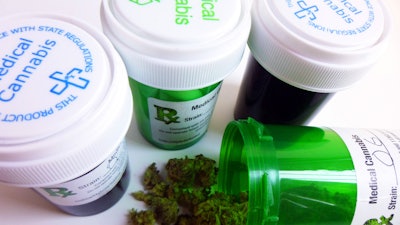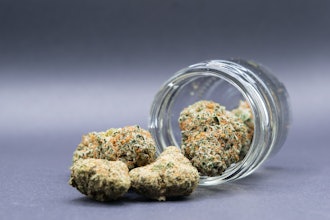
WALTHAM, Mass. — While some industries faltered during the COVID-19 pandemic, cannabis was not one of them. U.S. sales of legal marijuana—both medical and recreational—reached $17.5 billion in 2020, an increase of 46 percent from the previous year. In Massachusetts, a surge of applicants received medical marijuana cards through telehealth appointments with state-certified physicians, granting them access to an array of cannabis-derived products—from tinctures to vape cartridges to infused lotions.
Yet even as cannabis is prescribed to treat everything from sore muscles to cancer, there is much that policymakers and physicians don't know about the drug and its users. For health economist Alexandra Kritikos, PhD’21, who got her start researching tobacco use among youth in Greece, the gray area surrounding cannabis—which has been legalized for medical use in 39 states, but remains illegal at the federal level—presented a fascinating challenge.
“The more I read, the more gaps I found in the literature,” says Kritikos, who studied health and behavioral health policy at Heller. “Prescribers are telling their patients, ‘Yes, you might be able to try cannabis for this reason,’ but do we actually know anything about dosing? About how much to take and what type? We don’t.”
An ambitious agenda
In 2016, Kritikos began a four-and-a-half year dissertation journey focused on medical marijuana patients in New York State, hoping to uncover usage patterns and demographic trends that could help legislators and healthcare workers better understand the medical cannabis landscape.
Her approach was nontraditional by necessity: Since clinical trials of cannabis are curtailed by federal regulations, Kritikos utilized sales data collected by local dispensaries as part of the state’s mandatory cannabis seed-to-sale tracking platform, in which every every plant’s growth, cultivation, and selling process is recorded. The data gave Kritikos a crucial window into the purchasing history of patients over a three-year period, including what form of cannabis they purchased, how often they purchased it, and its potency (products can contain high or low levels of either THC or CBD, both chemical compounds which are derived from cannabis but affect the body differently). The data also included demographic information for each patient, such as age and gender, and their approved medical condition.
While previous studies have analyzed aspects of seed-to-sale data, Kritikos’ was the first to link patient demographics with purchasing behavior. In her three-part dissertation, which she defended in May, Kritikos reported groundbreaking findings on the buying patterns of various categories of patients, describing quantifiable differences between customers of different ages, genders, and those who use cannabis to treat physical pain versus other conditions, including mental disorders.
Using a methodology borrowed from opioid studies, Kritikos’ dissertation also examined how patients’ behavior changed over time, both in the amount of product used and its strength. From there, she was able to quantify an average dose of THC, something the National Institute on Drug Abuse (NIDA) had identified as a top research priority.
Being able to identify a “standard dose” of cannabis, as one does with Tylenol or any prescription drug, is a crucial step forward for policymakers looking to prevent misuse of the drug, and for doctors who prescribe cannabis to their patients, said Rosalie Pacula, a drug policy economist and professor of health policy and management at the University of Southern California who was on Kritikos’ dissertation committee.
“The bench science has lagged far behind the public policy here, so we know very little about the motivations of patients who use medical cannabis as well as the trajectories of their medical use,” she says. “Alexandra’s dissertation provides very useful information on practical use patterns being observed in the real world.”
Kritikos’ dissertation findings are already being used to inform policy recommendations in Massachusetts. In October, her research was cited multiple times in a report issued by the Massachusetts Cannabis Control Commission. The Commission’s director of research Julie Johnson, PhD’15, who served on Kritikos’ dissertation committee, lauded Kritikos’ novel use of seed-to-sale data to assess patient behaviors, including whether they regularly consume alcohol and cannabis simultaneously.
“As science comes to better understand the myriad societal effects—including public health, public safety, clinical and economical effects—policymakers can more effectively regulate the legal industry in a way that protects the public’s interests while allowing safe access to cannabis for adults and patients,” she says.
Entering the policy world
Kritikos arrived at Heller after earning a master’s degree in applied economics from Northeastern University and quickly became enamored with the school’s multidisciplinary approach to public policy.
“People were coming together and thinking about research questions from so many different lenses,” she recalls. “I loved it.”
While working on her dissertation, Kritikos was supported by mentors from across Heller, including Johnson and Professor Dominic Hodgkin, who served as her advisor and chaired her dissertation committee. Hodgkin, also an economist, praised Kritikos for her creativity and resourcefulness as a researcher in an emerging field: “Alexandra's study helps to fill the knowledge gap about this emerging delivery model for medical cannabis,” he says.
Ultimately, her Heller experience solidified Kritikos’ passion for health economics. In August, she began a new position as a postdoctoral researcher at University of Southern California, working under Pacula at the Schaeffer Center for Health Policy & Economics. The research questions she’ll be exploring are uncharted, such as whether medical dispensaries are influenced by recreational shops or how innovations like THC-infused beverages and vaping devices are impacting patient behavior, but Kritikos is comfortable operating without a roadmap.
“My dissertation was very difficult because there were no guidelines and no code books for me to use,” she says. “I’m happy I could shed some light on this topic and help future policymakers evaluate cannabis with the same guidelines as any other medication.”






















